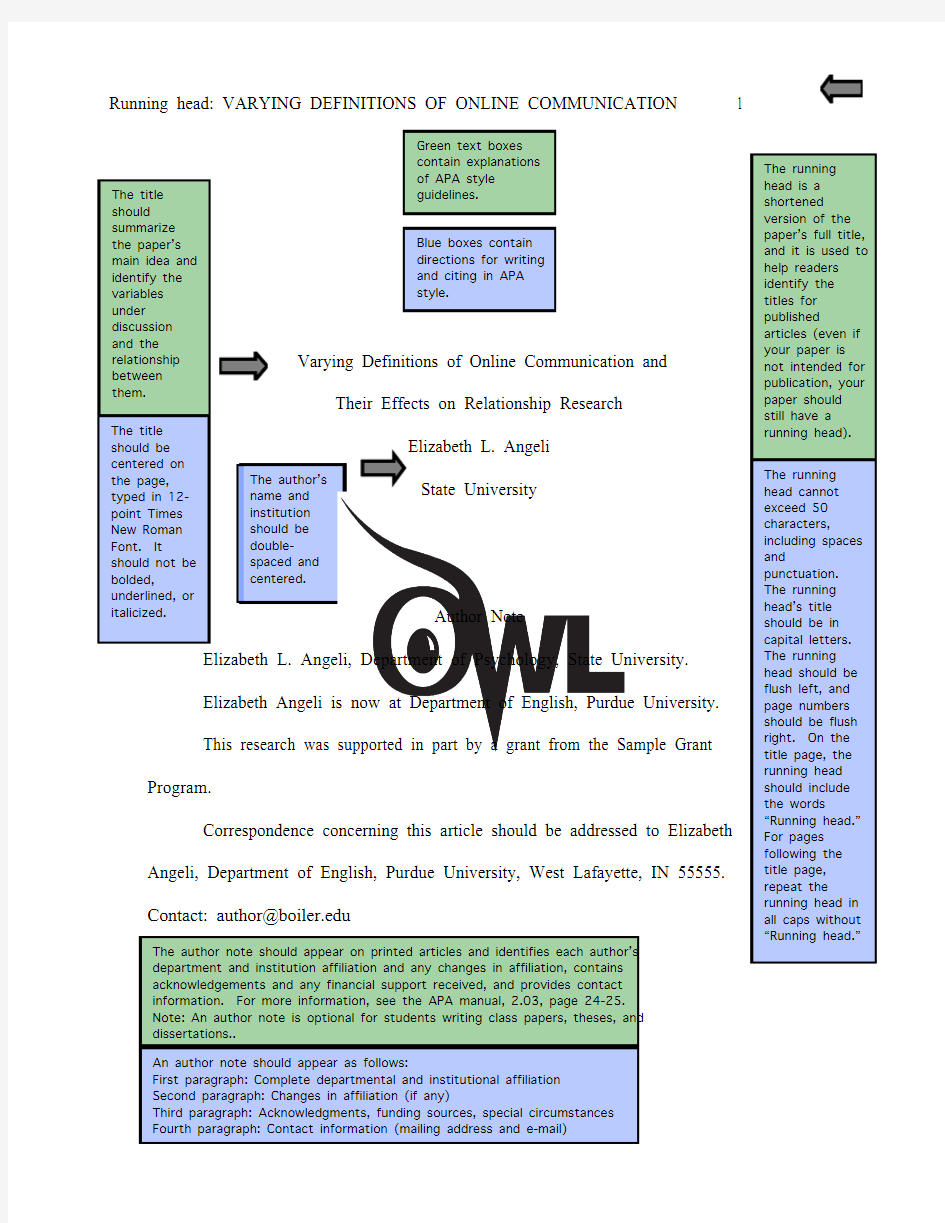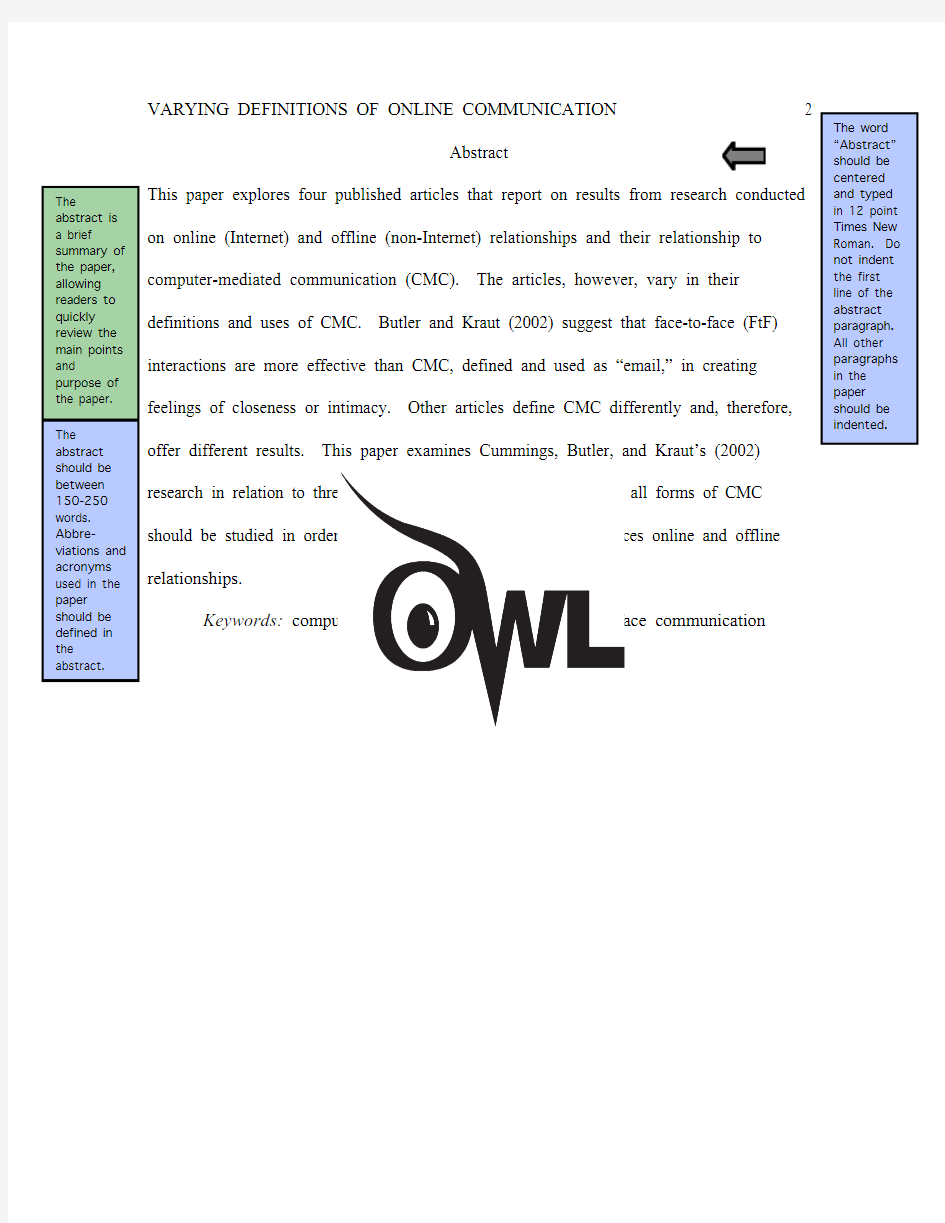APA 样本格式


Varying Definitions of Online Communication and
Their Effects on Relationship Research
Elizabeth L. Angeli
State University
Author Note
Elizabeth L. Angeli, Department of Psychology, State University.
Elizabeth Angeli is now at Department of English, Purdue University.
This research was supported in part by a grant from the Sample Grant Program.
Angeli, Department of English, Purdue University, West Lafayette, IN 55555.
Contact: author@https://www.360docs.net/doc/3c13712977.html,
The author’s
name and
institution
should be
double-
spaced and
centered.
Running head: VARYING DEFINITIONS OF ONLINE COMMUNICATION 1
VARYING DEFINITIONS OF ONLINE COMMUNICATION
Abstract
This paper explores four published articles that report on results from research conducted on online (Internet) and offline (non-Internet) relationships and their relationship to computer-mediated communication (CMC). The articles, however, vary in their definitions and uses of CMC. Butler and Kraut (2002) suggest that face-to-face (FtF) interactions are more effective than CMC, defined and used as “email,” in creating feelings of closeness or intimacy. Other articles define CMC differently and, therefore, offer different results. This paper examines Cummings, Butler, and Kraut’s (2002) research in relation to three other research articles to suggest that all forms of CMC should be studied in order to fully understand how CMC influences online and offline relationships.
Keywords: computer-mediated communication, face-to-face communication
VARYING DEFINITIONS OF ONLINE COMMUNICATION 3 Varying Definitions of Online Communication and
Their Effects on Relationship Research
focusing on the levels of intimacy, closeness, different communication modalities, and the frequency of use of computer-mediated communication (CMC). However, contradictory results are suggested within this research because only certain aspects of CMC are investigated, for example, email only. Cummings, Butler, and Kraut (2002) suggest that face-to-face (FtF) interactions are more effective than CMC (read: email) in creating feelings of closeness or intimacy, while other studies suggest the opposite. To
by CMC, all forms of CMC should be studied. This paper examines Cummings et al.’s research against other CMC research to propose that additional research be conducted to
better understand how online communication affects relationships.
Literature Review
In Cummings et al.’s (2002) summary article reviewing three empirical studies on online social relationships, it was found that CMC, especially email, was less effective than FtF contact in creating and maintaining close social relationships. Two of the three reviewed studies focusing on communication in non-Internet and Internet relationships mediated by FtF, phone, or email modalities found that the frequency of each modality’s use was significantly linked to the strength of the particular relationship (Cummings et al., 2002). The strength of the relationship was predicted best by FtF and phone
communication, as participants rated email as an inferior means of maintaining personal
relationships as compared to FtF and phone contacts (Cummings et al., 2002).
Cummings et al. (2002) reviewed an additional study conducted in 1999 by the HomeNet project (see Appendix A for more information on the HomeNet project). In this project, Kraut, Mukhopadhyay, Szczypula, Kiesler, and Scherlis (1999) compared the value of using CMC and non-CMC to maintain relationships with partners. They found that participants corresponded less frequently with their Internet partner (5.2 times per month) than with their non-Internet partner (7.2 times per month) (as cited in Cummings et al., 2002). This difference does not seem significant, as it is only two times less per month. However, in additional self-report surveys, participants responded feeling more distant, or less intimate, towards their Internet partner than their non-Internet partner. This finding may be attributed to participants’ beliefs that email is an inferior mode of personal relationship communication.
Intimacy is necessary in the creation and maintenance of relationships, as it is defined as the sharing of a person’s innermost being with another person, i.e., self-disclosure (Hu, Wood, Smith, & Westbrook, 2004). Relationships are facilitated by the reciprocal self-disclosing between partners, regardless of non-CMC or CMC. Cummings et al.’s (2002) reviewed results contradict other studies that research the connection between intimacy and relationships through CMC.
Hu et al. (2004) studied the relationship between the frequency of Instant Messenger (IM) use and the degree of perceived intimacy among friends. The use of IM
instead of email as a CMC modality was studied because IM supports a non-professional
environment favoring intimate exchanges (Hu et al., 2004). Their results suggest that a positive relationship exists between the frequency of IM use and intimacy, demonstrating that participants feel closer to their Internet partner as time progresses through this CMC modality.
Similarly, Underwood and Findlay (2004) studied the effect of Internet relationships on primary, specifically non-Internet relationships and the perceived intimacy of both. In this study, self-disclosure, or intimacy, was measured in terms of shared secrets through the discussion of personal problems. Participants reported a significantly higher level of self-disclosure in their Internet relationship as compared to their primary relationship. In contrast, the participants’ primary relationships were reported as highly self-disclosed in the past, but the current level of disclosure was perceived to be lower (Underwood & Findlay, 2004). This result suggests participants turned to the Internet in order to fulfill the need for intimacy in their lives.
In further support of this finding, Tidwell and Walther (2002) hypothesized CMC participants employ deeper self-disclosures than FtF participants in order to overcome the limitations of CMC, e.g., the reliance on nonverbal cues. It was found that CMC partners engaged in more frequent intimate questions and disclosures than FtF partners in order to overcome the barriers of CMC. In their 2002 study, Tidwell and Walther measured the perception of a relationship’s intimacy by the partner of each participant in both the CMC and FtF conditions. The researchers found that the participants’ partners stated their CMC partner was more effective in employing more intimate exchanges than their FtF
partner, and both participants and their partners rated their CMC relationship as more intimate than their FtF relationship.
Discussion
In 2002, Cummings et al. stated that the evidence from their research conflicted
with other data examining the effectiveness of online social relationships. This statement is supported by the aforementioned discussion of other research. There may be a few possible theoretical explanations for these discrepancies. Limitations of These Studies
The discrepancies identified may result from a number of limitations found in the
materials reviewed by Cummings et al. These limitations can result from technological constraints, demographic factors, or issues of modality. Each of these limitations will be examined in further detail below.
Technological limitations. First, one reviewed study by Cummings et al. (2002)
examined only email correspondence for their CMC modality. Therefore, the study is limited to only one mode of communication among other alternatives, e.g., IM as studied by Hu et al. (2004). Because of its many personalized features, IM provides more personal CMC. For example, it is in real time without delay, voice-chat and video features are available for many IM programs, and text boxes can be personalized with the user’s picture, favorite colors and text, and a wide variety of emoticons, e.g., :). These options allow for both an increase in self-expression and the ability to overcompensate for the barriers of CMC through customizable features, as stated in Tidwell and Walther
(2002). Self-disclosure and intimacy may result from IM’s individualized features, which are not as personalized in email correspondence.
Demographic limitations. In addition to the limitations of email, Cummings et al. (2002) reviewed studies that focused on international bank employees and college students (see Appendix B for demographic information). It is possible the participants’ CMC through email was used primarily for business, professional, and school matters and not for relationship creation or maintenance. In this case, personal self-disclosure and intimacy levels are expected to be lower for non-relationship interactions, as this communication is primarily between boss and employee or student and professor. Intimacy is not required, or even desired, for these professional relationships.
Modality limitations. Instead of professional correspondence, however, Cummings et al.’s (2002) review of the HomeNet project focused on already established relationships and CMC’s effect on relationship maintenance. The HomeNet researchers’ sole dependence on email communication as CMC may have contributed to the lower levels of intimacy and closeness among Internet relationships as compared to non-Internet relationships (as cited in Cummings et al., 2002). The barriers of non-personal communication in email could be a factor in this project, and this could lead to less intimacy among these Internet partners. If alternate modalities of CMC were studied in both already established and professional relationships, perhaps these results would have resembled those of the previously mentioned research.
Conclusions and Future Study Array In order to gain a complete understanding of CMC’s true effect on both online and offline relationships, it is necessary to conduct a study that examines all aspects of CMC. This includes, but is not limited to, email, IM, voice-chat, video-chat, online journals and diaries, online social groups with message boards, and chat rooms. The effects on relationships of each modality may be different, and this is demonstrated by the discrepancies in intimacy between email and IM correspondence. As each mode of communication becomes more prevalent in individuals’ lives, it is important to examine the impact of all modes of CMC on online and offline relationship formation,
maintenance, and even termination.
References
Cummings, J. N., Butler, B., & Kraut, R. (2002). The quality of online social relationships. Communications of the ACM, 45(7), 103-108.
Hu, Y., Wood, J. F., Smith, V., & Westbrook, N. (2004). Friendships through IM: Examining the relationship between instant messaging and intimacy. Journal of
Computer-Mediated Communication, 10, 38-48.
Tidwell, L. C., & Walther, J. B. (2002). Computer-mediated communication effects on disclosure, impressions, and interpersonal evaluations: Getting to know one
another a bit at a time. Human Communication Research, 28, 317-348. Underwood, H., & Findlay, B. (2004). Internet relationships and their impact on primary relationships. Behaviour Change, 21(2), 127-140.
Start the reference list on a new page, center the title “References,” and
alphabetize the entries. Do not underline or italicize the title. Double-space all
entries. Every source mentioned in the paper should have an entry.
Appendix A
The HomeNet Project
Started at Carnegie Mellon University in 1995, the HomeNet research project has involved a number of studies intended to look at home Internet usage. Researchers began this project because the Internet was originally designed as a tool for scientific and corporate use. Home usage of the Internet was an unexpected phenomenon worthy of extended study.
Each of HomeNet’s studies has explored a different facet of home Internet usage, such as chatting, playing games, or reading the news. Within the past few years, the explosion of social networking has also proven to be an area deserving of additional research. Refer to Table A1 for a more detailed description of HomeNet studies.
Table A1
Description of HomeNet Studies by Year
Year o f S tudy Contents o f S tudy
1995--‐1996 93 families in Pittsburgh involved in school
or community organizations
1997--‐1999 25 families with home businesses
1998--‐1999 151 Pittsburgh households
2000--‐2002 National survey
Appendix B
Demographic Information for Cummings et al. (2002)’s Review
